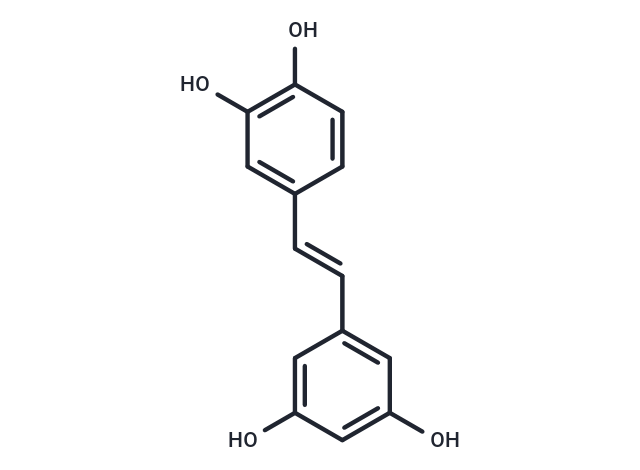Shopping Cart
- Remove All
 Your shopping cart is currently empty
Your shopping cart is currently empty

Piceatannol (Astringenin) is an anti-inflammatory, immunomodulatory and antiproliferative agent. It inhibits p56lck and syk protein tyrosine kinases and inhibits NF-κB activation and gene expression of TNF-induced. It is synthetic from the conversion of resveratrol by cytochrome P450 1B1.

| Pack Size | Price | Availability | Quantity |
|---|---|---|---|
| 5 mg | $39 | In Stock | |
| 10 mg | $61 | In Stock | |
| 25 mg | $117 | In Stock | |
| 50 mg | $170 | In Stock | |
| 100 mg | $240 | In Stock | |
| 500 mg | $588 | In Stock | |
| 1 mL x 10 mM (in DMSO) | $50 | In Stock |
| Description | Piceatannol (Astringenin) is an anti-inflammatory, immunomodulatory and antiproliferative agent. It inhibits p56lck and syk protein tyrosine kinases and inhibits NF-κB activation and gene expression of TNF-induced. It is synthetic from the conversion of resveratrol by cytochrome P450 1B1. |
| Targets&IC50 | PKC:8 μM, MLCK:12 μM, CAK:3 μM |
| In vitro | In mast cells, Piceatannol is an effective inhibitor of histamine release, selectively suppressing Syk to block receptor-mediated cellular responses, including inhibition of 1,4,5-IP3 secretion, synthesis, membrane ruffling, and transportation. Piceatannol inhibits Syk activity approximately tenfold more potently than Lyn. When RBL-2H3 cells are treated with Piceatannol, antigen-stimulated phosphorylation of Syk and most other cellular proteins is strongly inhibited. However, it doesn’t affect the phosphorylation of receptor gamma or beta subtypes, presenting a dose-dependent inhibition. Piceatannol also effectively inhibits CDPK, MLCK, PKC, and PKA, with IC50 values of 19 μM, 12 μM, 8 μM, and 3 μM respectively. It selectively inhibits IFNα-induced tyrosine phosphorylation of STAT3/5 without affecting STAT1/2 and selectively inhibits the dephosphorylation of tyrosine on Jak1 and IFNAR1, not affecting Tyk2 and IFNAR2. Piceatannol induces apoptosis in BJAB Burkitt-like lymphoma cells via the activation of caspase-3 and changes in mitochondrial permeability, with an ED50 of 25 μM, independent of the CD95/Fas signaling pathway. It inhibits NF-κB activation induced by TNF, H2O2, PMA, lipopolysaccharides, okadaic acid, and ceramide. Specifically, it inhibits TNF-induced expression of NF-κB-dependent reporter genes (matrix metalloproteinase-9, cyclooxygenase-2, and cyclin D1) by blocking TNF-induced IκBαof phosphorylation, p65 nuclear translocation, and IκB kinase activation, independent of tyrosine kinase. Piceatannol binds to intracellular phosphatidylinositol kinase in an ATP-competitive manner, inhibiting its activity and exhibiting anti-atherosclerotic effects superior to resveratrol. Lastly, Piceatannol suppresses the proliferation of both androgen-dependent and -independent CaP cells and notably reduces the expression of mTOR and its key effectors AKT and eIF4EBP-1. |
| In vivo | Oral administration of Piceatannol significantly ameliorates structural damage to the colon in BALB/c mice with dextran sulfate sodium-induced colitis, markedly reducing the production of inflammatory mediators (such as nitric oxide, prostaglandin E2, and pro-inflammatory cytokines), and notably diminishes colonic myeloperoxidase (MPO) activity. In type 2 diabetic db/db mouse models, Piceatannol suppresses early elevation of blood glucose levels and improves impaired glucose tolerance in later stages. |
| Kinase Assay | In Vitro Protein-tyrosine Kinase Assays: Recombinant Syk is expressed in baculovirus-infected St9 cells. Assays of recombinant Syk activity are carried out using angiotensin I peptide as substrate. The enzyme activities of recombinant Syk are measured by phosphorylation of angiotensin I peptide in the presence of various concentrations of Piceatannol. |
| Cell Research | Cells are exposed to increasing concentrations of Piceatannol. For the determination of cell proliferation, cells are assayed at 72 hours by trypan blue exclusion using a hemocytometer. After 1 week, colonies are stained with 1.25% crystal violet and quantified by measuring the absorbance at 595 nm. (Only for Reference) |
| Alias | trans-Piceatannol, Astringenin |
| Molecular Weight | 244.24 |
| Formula | C14H12O4 |
| Cas No. | 10083-24-6 |
| Smiles | C(=C/C1=CC(O)=CC(O)=C1)\C2=CC(O)=C(O)C=C2 |
| Relative Density. | 1.1245 g/cm3 (Estimated) |
| Storage | Powder: -20°C for 3 years | In solvent: -80°C for 1 year | Shipping with blue ice. | ||||||||||||||||||||||||||||||||||||||||
| Solubility Information | Ethanol: 24.4 mg/mL (99.9 mM), Sonication is recommended. DMSO: 160 mg/mL (655.09 mM), Sonication is recommended. | ||||||||||||||||||||||||||||||||||||||||
Solution Preparation Table | |||||||||||||||||||||||||||||||||||||||||
Ethanol/DMSO
DMSO
| |||||||||||||||||||||||||||||||||||||||||

Copyright © 2015-2025 TargetMol Chemicals Inc. All Rights Reserved.